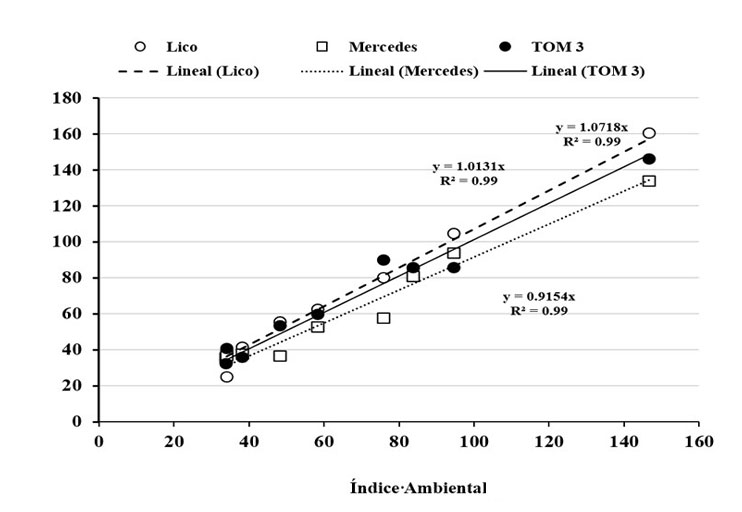Mercedes: a sorghum variety for the production of high-quality forage in Durango, Mexico
DOI:
https://doi.org/10.29312/remexca.v15i1.2958Keywords:
Sorghum bicolor, adaptability, qualified seed, yieldAbstract
Agricultural production constantly requires low-priced sorghum seed to reduce costs in forage production. The objective was to develop a sorghum variety adapted to irrigation and rainfed conditions to produce high-quality forage. The Mercedes variety (LAM-1m-2m-3u) was developed by mass selection from a heterogeneous population collected in Las Mercedes, Durango. This variety exceeded the state average yield (32.7 t ha-1), with an average production of fresh forage under irrigation of 42.1 t ha-1. The Mercedes variety, compared to TOM 3, showed fewer days to the emergence of the panicle (81 vs 93 days after sowing: DAS), cut height (256 vs 297 cm), and greater grain weight (17.4 g/1 000 seeds vs 12.8 g/1000 seeds). Mercedes is mainly recommended for producing forage (fresh and silage). The caryopsis is red-orange and shows a long grain surface covered by the glume. Mercedes showed resistance to ergot (Claviceps spp.) and tolerance to lodging. The process of technological transfer of the Mercedes variety is advanced, and the values of yield and quality of forage were corroborated.
Downloads
References
Domínguez, M. P. A.; Jiménez, O. R.; Rosales, S. R.; Galindo, V. C. F. y Santana, E. S. 2016. Estabilidad del rendimiento forrajero de tres variedades de sorgo dulce. AGROFAZ. 16(2):27-33.
Montes, G. N.; Williams, A. H.; Arcos, C. G.; Medina, G. S.; Palacios, V. O.; Moreno, G. T.; Cisneros, L. M. E. y Pecina, Q. V. 2010. RB Paloma: variedad de sorgo Sorghum bicolor (L.) Moench de grano blanco para riego y buen temporal. INIFAP-CIRNE-Campo Experimental Río Bravo. Río Bravo, Tamaulipas, México. 1 p.
Nava, B. C. A.; Rosales, S. R.; Jiménez, O. R.; Carrete, C. F. O.; Domínguez, M. P. A. y Murillo, O. M. 2017. Rendimiento y valor nutricional de tres variedades de sorgo dulce cultivadas en cuatro ambientes de Durango. Rev. Mex. Cienc. Pec. 8(2):147-155.
SIAP. 2023. Servicio de Información Agroalimentaria y Pesquera. Anuario estadístico de la producción agrícola. https://nube.siap.gob.mx/cierreagricola/.
SNICS. 2019. Servicio Nacional de Inspección y Certificación de Semillas. Catálogo nacional de variedades vegetales Núm. 16. SNICS-SADER. Coyoacán, Ciudad de México. 107 p.
UPOV. 2015. Unión International para la Protección de las Obtenciones Vegetales. Directrices para la ejecución del examen de la distinción, la homogeneidad y la estabilidad. Sorgo. Ginebra, Suiza. 35 p.

Published
How to Cite
Issue
Section
License
Copyright (c) 2024 Revista Mexicana de Ciencias Agrícolas

This work is licensed under a Creative Commons Attribution-NonCommercial 4.0 International License.
The authors who publish in Revista Mexicana de Ciencias Agrícolas accept the following conditions:
In accordance with copyright laws, Revista Mexicana de Ciencias Agrícolas recognizes and respects the authors’ moral right and ownership of property rights which will be transferred to the journal for dissemination in open access. Invariably, all the authors have to sign a letter of transfer of property rights and of originality of the article to Instituto Nacional de Investigaciones Forestales, Agrícolas y Pecuarias (INIFAP) [National Institute of Forestry, Agricultural and Livestock Research]. The author(s) must pay a fee for the reception of articles before proceeding to editorial review.
All the texts published by Revista Mexicana de Ciencias Agrícolas —with no exception— are distributed under a Creative Commons License Attribution-NonCommercial 4.0 International (CC BY-NC 4.0), which allows third parties to use the publication as long as the work’s authorship and its first publication in this journal are mentioned.
The author(s) can enter into independent and additional contractual agreements for the nonexclusive distribution of the version of the article published in Revista Mexicana de Ciencias Agrícolas (for example include it into an institutional repository or publish it in a book) as long as it is clearly and explicitly indicated that the work was published for the first time in Revista Mexicana de Ciencias Agrícolas.
For all the above, the authors shall send the Letter-transfer of Property Rights for the first publication duly filled in and signed by the author(s). This form must be sent as a PDF file to: revista_atm@yahoo.com.mx; cienciasagricola@inifap.gob.mx; remexca2017@gmail.
This work is licensed under a Creative Commons Attribution-Noncommercial 4.0 International license.


